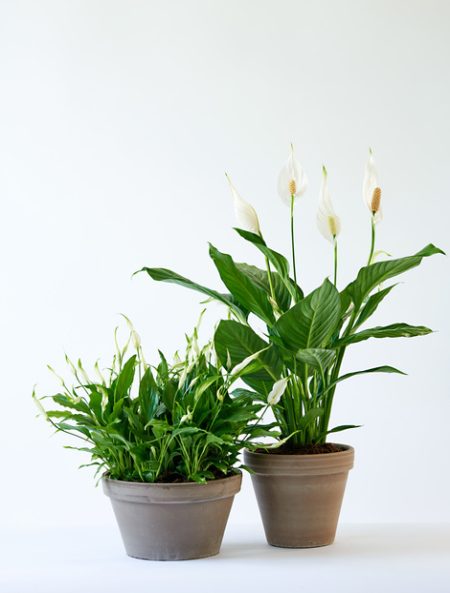29 Apr Peace Lily: Houseplant of the Month May 2020
Peace Lily
The peace lily, also known as Spathiphyllum, will be featured as the Houseplant of the Month in May.
Stylish dark green leaves with radiant white banners floating above them, and caring and communicative as well: the Peace lily is bound to steal your heart.
The peace lily’s official name, Spathiphyllum, is derived from the Greek words for spathe and leaf. The peace lily originates from the tropical rainforests of Colombia and Venezuela. It’s a real shade plant that likes a warm, damp environment. The plant was introduced into Europe in 1870, and has enjoyed a rapid development since then. While there were only a few varieties derived from the walisii species in the 1980s, there are now a large number of cultivars.
Colours and shapes
The stylish Peace lily offers a full clump of soft, dark pointed leaves with elegant white bracts in between. These are often thought to be flowers, but the actual flowers are tiny and on the spike (also called the ear). The Peace lily has completely mastered body language. If the soil is too dry, the stems droop pitifully. If you then pour in some water, it’ll be fresh and lively again an hour later. In exchange for your good care, this houseplant also cares for you: it’s one of the plants with air-purifying qualities according to the NASA Clean Air Study.

Origin
Peace Lily (officially called Spathiphyllum) is a member of the Araceae (Arum) family and grows in the tropical rainforests of Colombia and Venezuela. The plant was introduced into Europe in 1870. Over 50 different cultivars are known, which virtually all have white flowers with the occasional slight green tinge. The name Spathiphyllum is derived from the Greek: ‘spath’ is a spoon, ‘phyl’ means leaves – a reference to the spoon-shaped leaf.
Care tips for customers

The Peace Lily is an easy care product.
- The plant requires a light position, out of bright sunlight at around 18-22 °C.
- Regularly give the plant tepid water. If the leaves are drooping, the soil has dried out.
- The plant enjoys regular spraying with tepid water, and also appreciate plant food.
- Removing wilted flowers is a good idea.
- A winter rest period is required in order to get the flower to bloom for several years. The plant should then be placed in a light spot at a temperature of 15 °C for 6 to 8 weeks, after which it will flower vigorously again.
- The plant can also be placed in the garden or on the patio in the summer, but beware of bright sunlight
Sales and display tips for the peace lily
Its air-purifying properties* make the peace lily very popular. This easy plant also has calming effects thanks to its simple flowing leaf shapes. Place it in a pot made of natural material, ceramic or (artificial) resin. The plant looks even more serene behind a matt or semi-transparent screen.
*In the Nasa Clean Air study, the peace lily stood out for its above-average air purifying qualities and has therefore gained extra popularity. However, during the times of the Covid-19 (Coronavirus) pandemic, we advise not to emphasize this property specifically as this can of course be sensitive or misinterpreted.
Images of the peace lily
You can download and use the images below free of charge if you credit Thejoyofplants.co.uk.
Instagram: @thejoyofplants
Facebook: @thejoyofplants
Twitter: @thejoyofplants
Peace lily poster:
You can download the posters free of charge using the links below.


